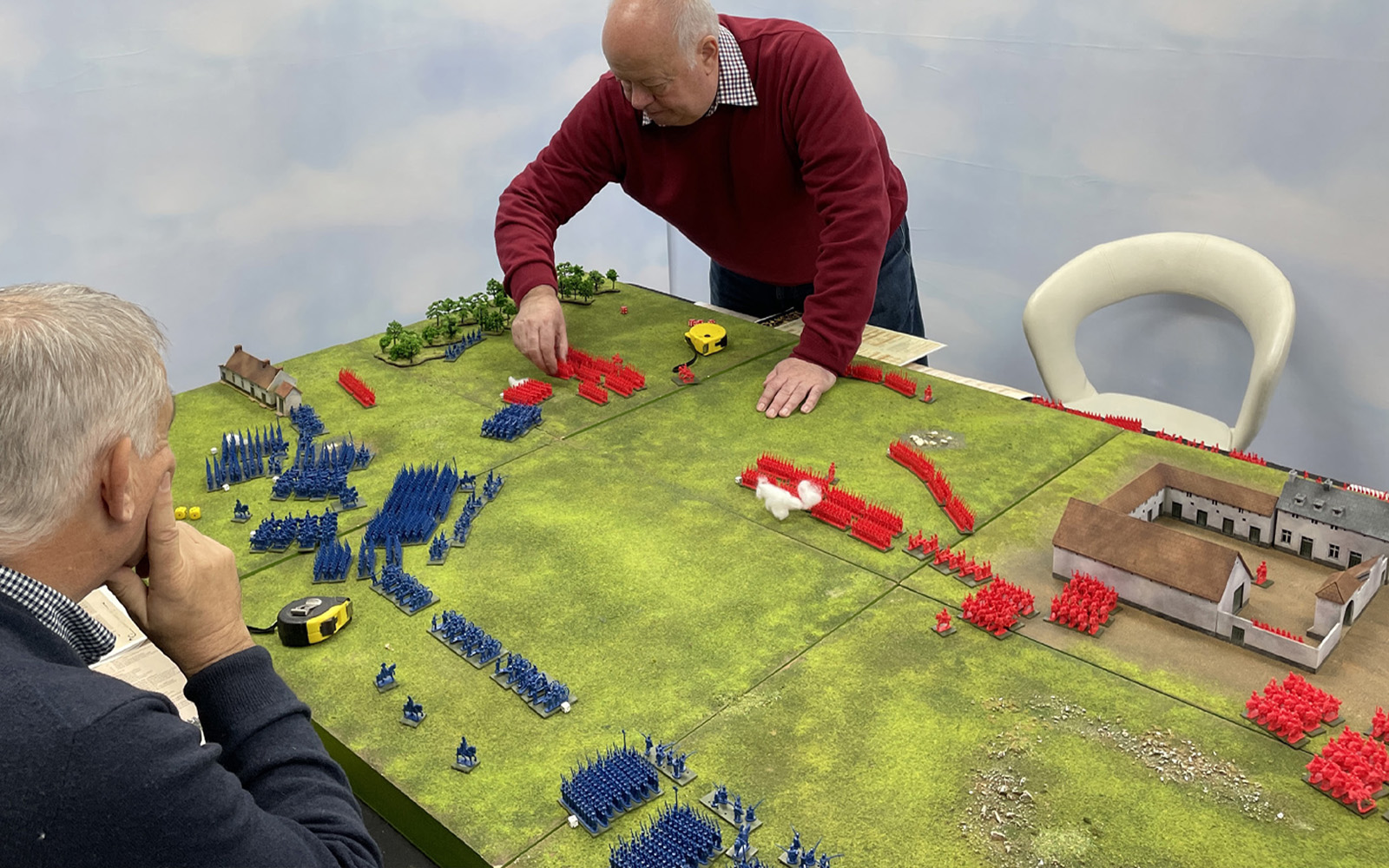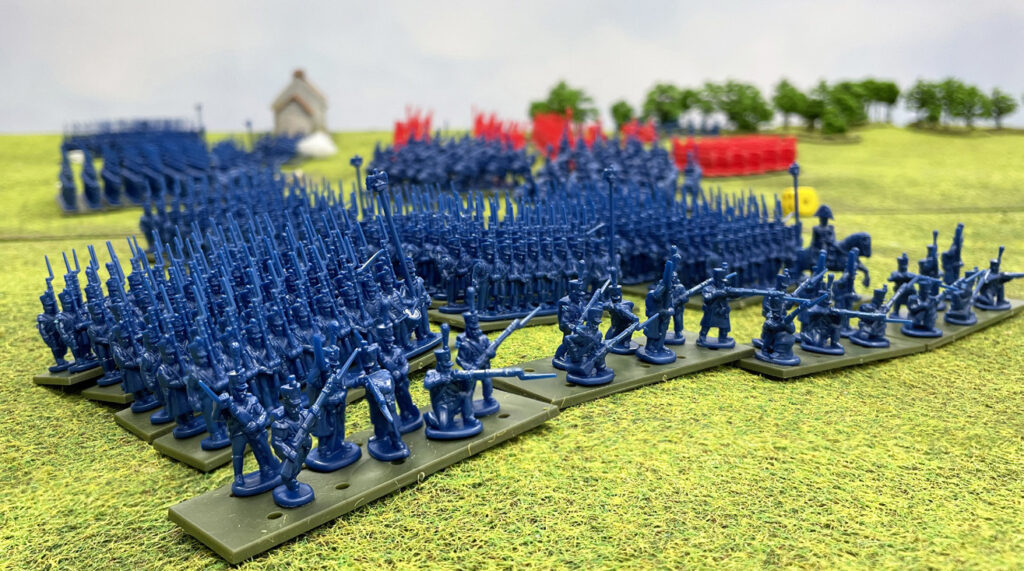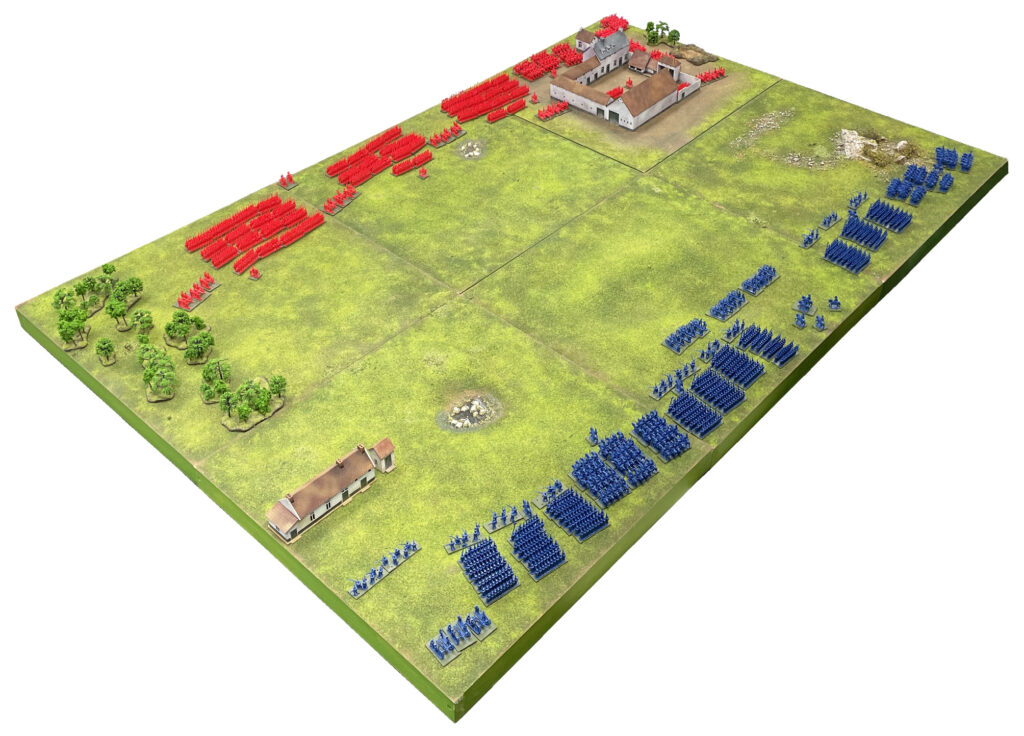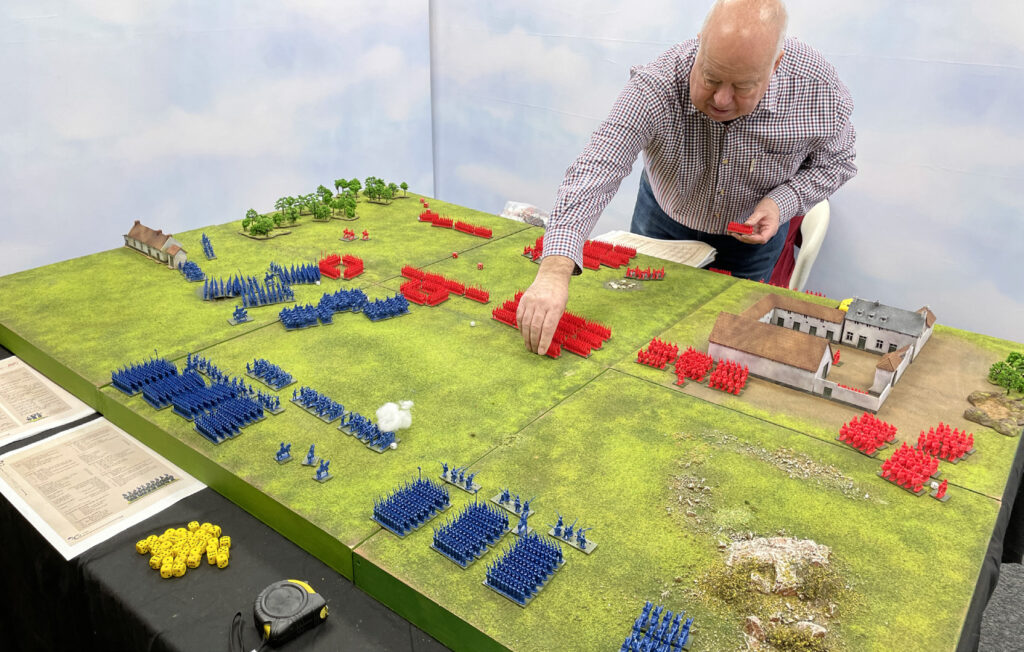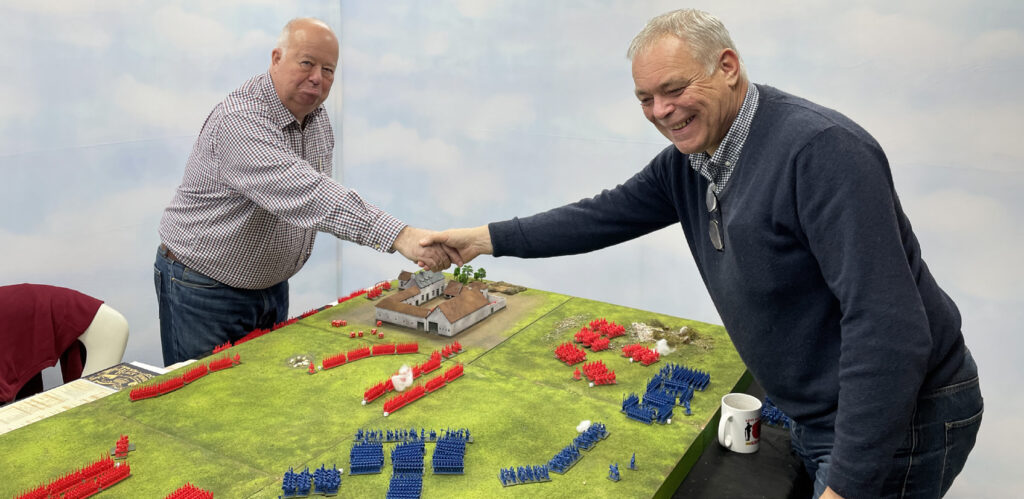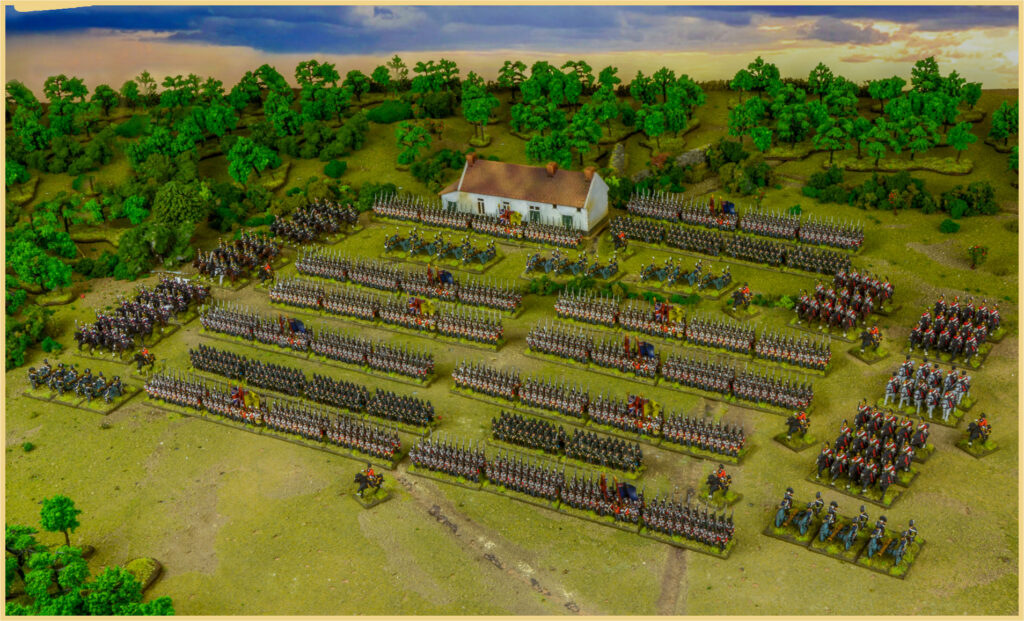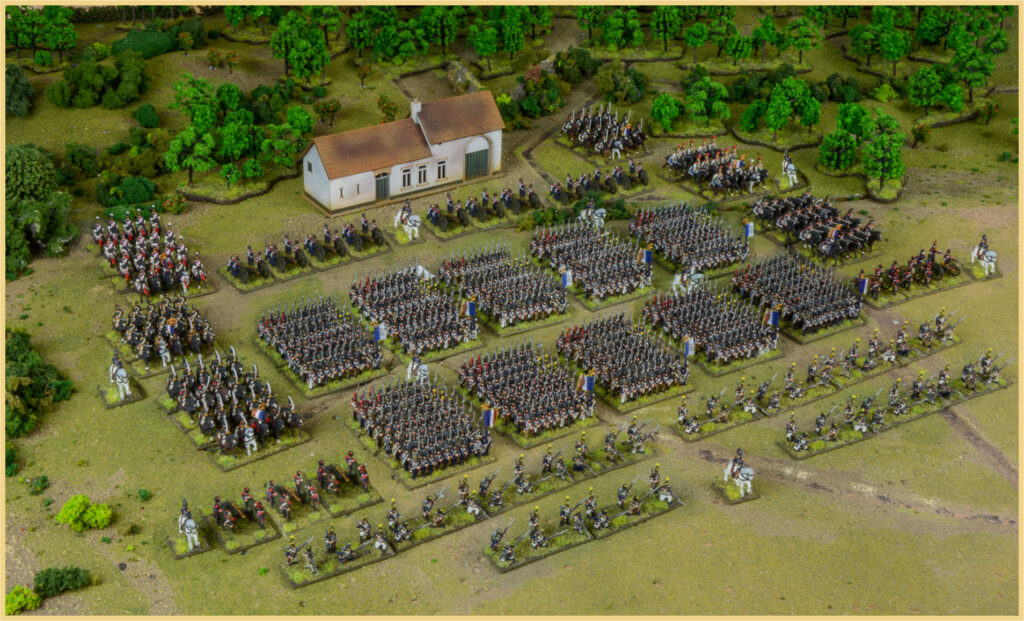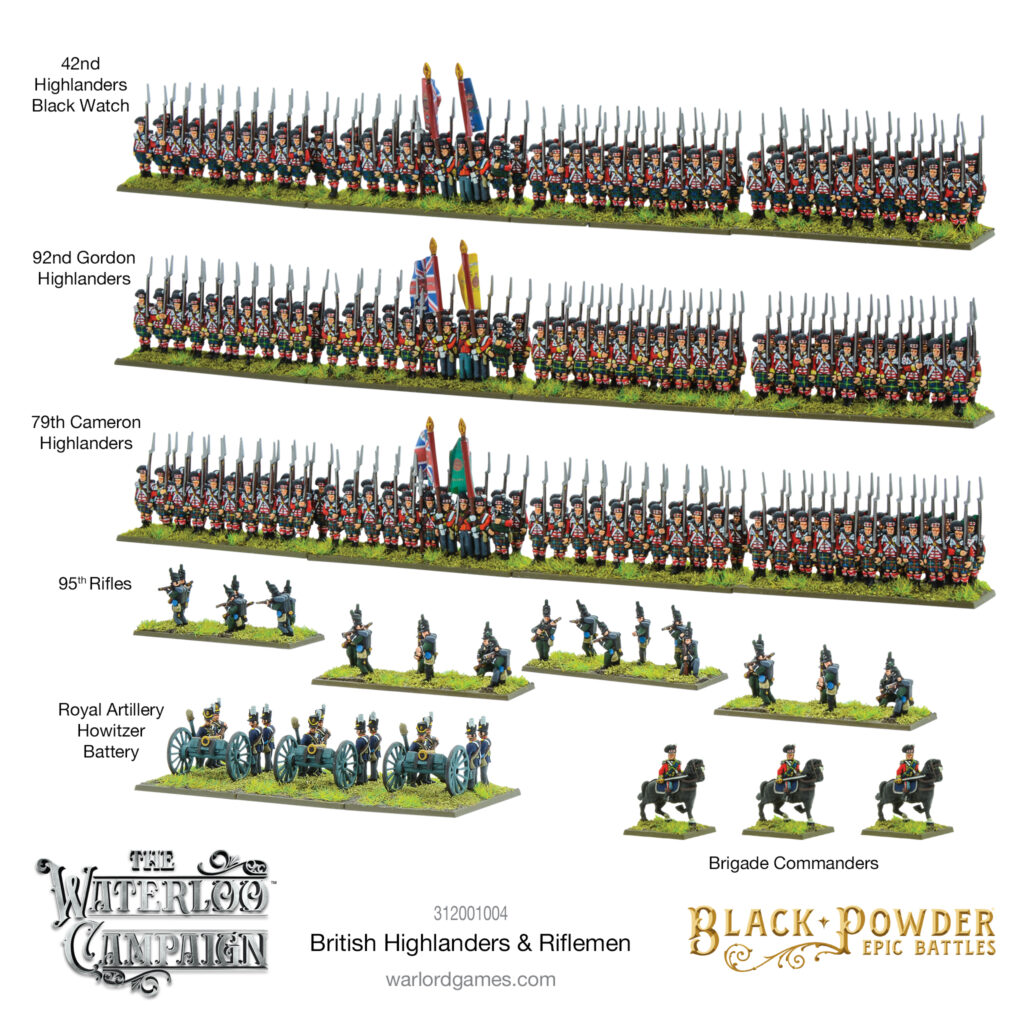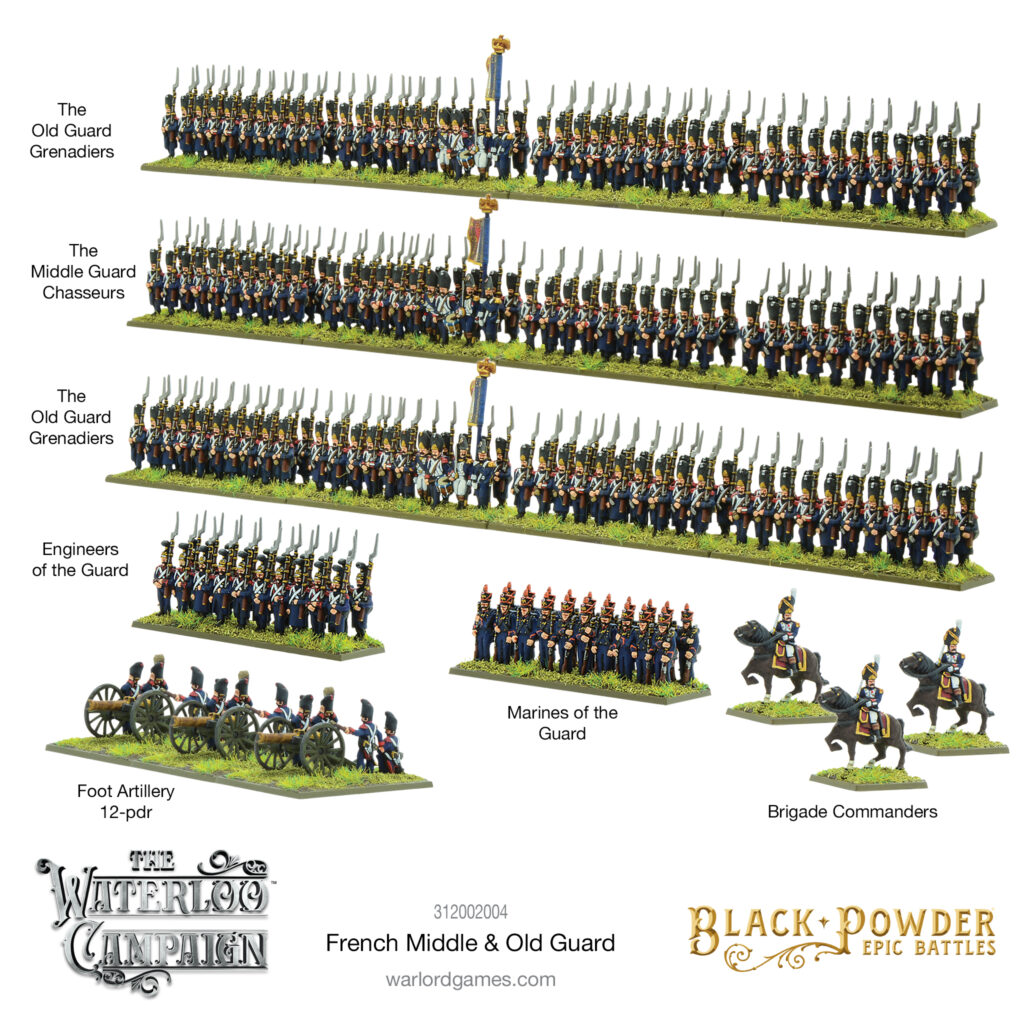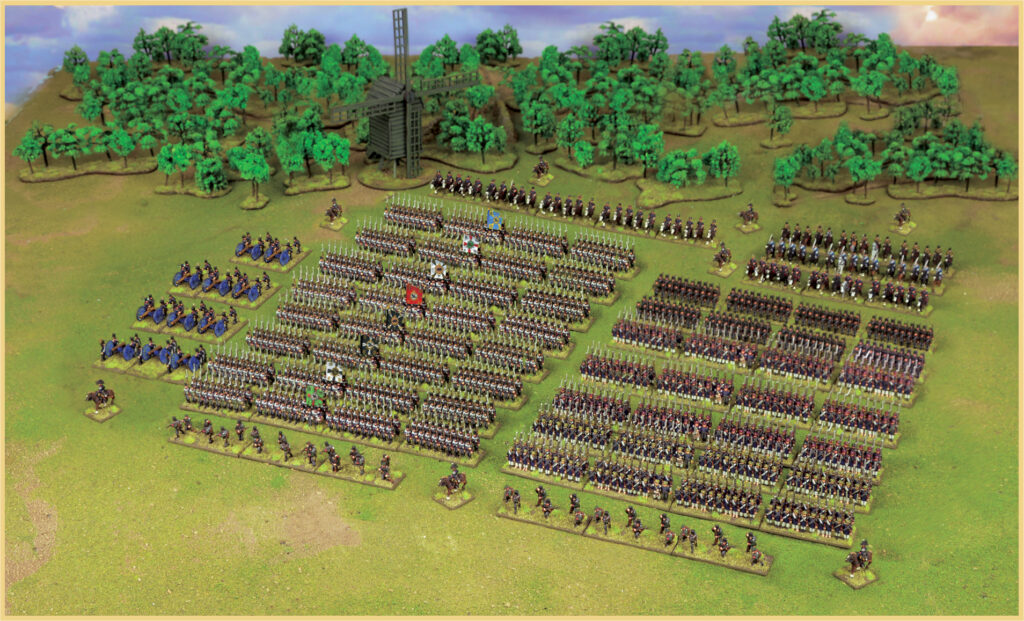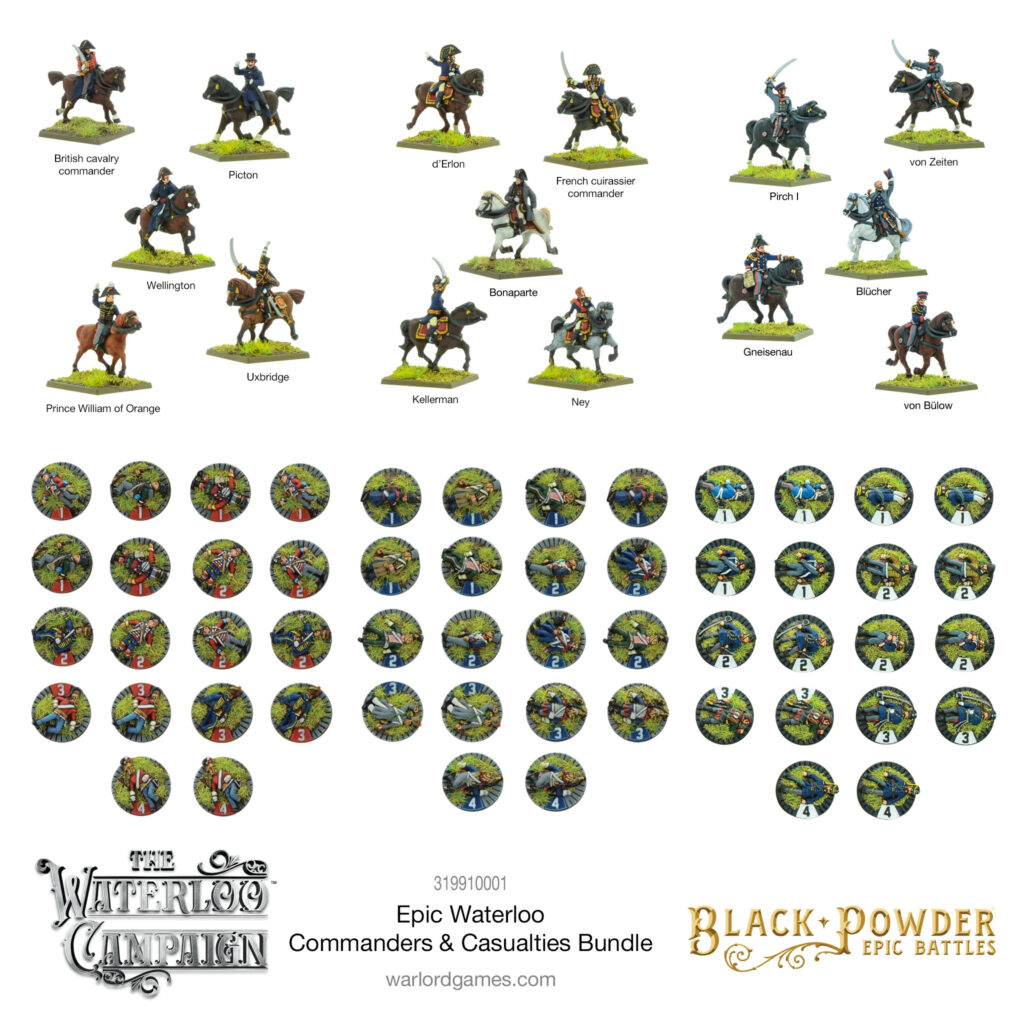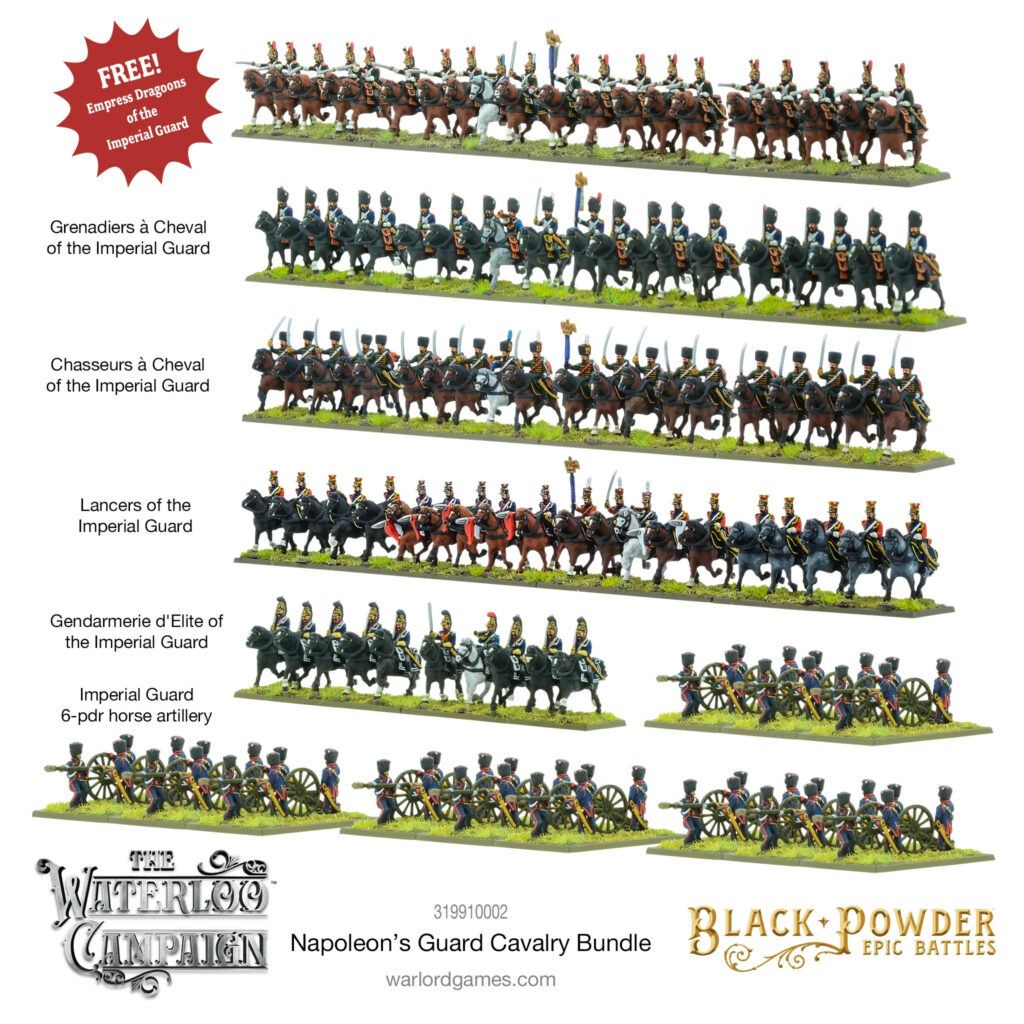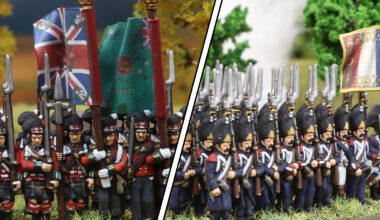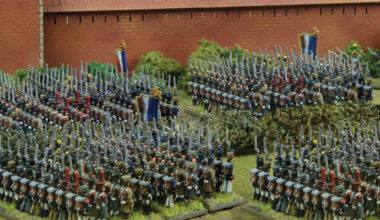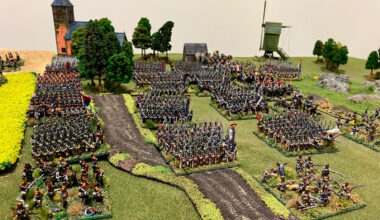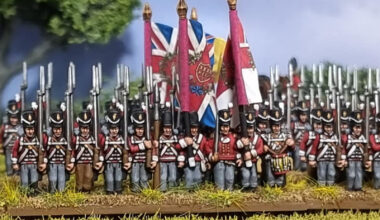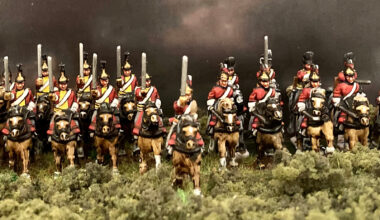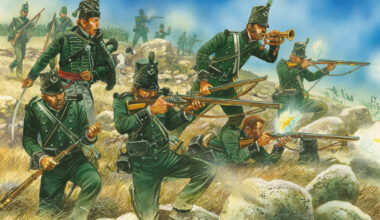This article first appeared in Wargames Illustrated and was written by the magazine’s editor, Dan Faulconbridge. The fine chaps at Wi have very kindly allowed us to reproduce the article here.
The plan was simple: find two experienced Black Powder gamers, bribe them with bottomless cups of coffee and a Tesco Meal Deal, and invite them over to the salubrious surroundings of WiHQ to play a game of Epic Battles: The Waterloo Campaign, using the figures and scenery from the British and French Starter Sets. The objective was to gauge their reaction to this first taste of Epic scale battles and report back to you, dear reader, on their findings.
Warlord Games were on the case when it came to supplying all the relevant models for the game, and when our two eager volunteers were presented with a 6′ x 4′ gaming table and two boxes containing all the ‘naked’ troops from the Starter Sets, their initial reaction was one of misty-eyed nostalgia, with thoughts turning to games of toy soldiers played out using Airfix figures in the early 1970s.
As a spritely 50 year old myself, this was lost on me (my gaming began with Warhammer First Edition), but clearly the unpainted red (British) and blue (French) coloured plastic models are going to put people of a certain vintage in mind of their introduction to the hobby. Having said that, one of our gamers, Andy Callan, did go on to say his early Napoleonic army was pieced together by clearing out all the local second-hand shops of copies of Risk, and using the pieces from that game to form to Epic(ish) scale forces!
Andy Callan was joined by pal Steve Wood to do Epic battle in the noble cause of research. As previously mentioned, both came to the table as self-confessed Black Powder fans, but neither had yet sampled Epic scale BP. They were keen to give it a go, however, and Andy had even done some homework: “Did you know the frontage of a Standard Unit in Epic scale is actually the same as that in 28mm? Four bases form a Unit, with a frontage of 240mm, that’s the same as the recommendation for 28s”. Much furrowing of brows and measuring of bases confirmed his observation. So we had all learnt something before we threw our first dice.
Setup
It’s no small task clipping the models from their frames and plugging them into their bases, but there are 16 frames worth of figures from the two sets to prep, so that’s no surprise. The Warlord guys had the welcome task of doing that for us – all Andy and Steve had to do was decant their forces onto the tabletop. As well as the resplendent red and blue infantry, cavalry, commanders, and artillery, we had also been provided with scenery in the form of N-Gauge trees and the Sarissa Precision made (and expertly painted) MDF buildings that accompany the Waterloo Campaign range.
Our game was going to be a no-nonsense, bog-standard, ‘meeting engagement’. We didn’t go for any scenario or historical refight. In laying out our battlefield, we gave a nod to Waterloo – positioning the Sandpit near La Haye Sainte – other than that, we went with something that would suit an open battle, with plenty of space in the centre and La Belle Alliance erroneously placed on the French left.
“I’m struggling to fit all my forces on the table”, was the plaintive cry from British Commander-in-Chief Steve. Having squeezed as much onto his baseline as possible, I made the Games Masterly decision that he could place one Brigade in and around La Haye Sainte. Over on the other side of the table, Andy’s French were a little more compact in their Column formations, but it is worth noting that if you arrange the entire contents of both Starter Sets on a 6Ꞌ x 4Ꞌ table it is going to be a tight fit. Any reasonable GM would have allowed some of the British forces to come on a turn later, but as I said, “This is show business, Steve, make sure you get all the toys on the table, it’s what the public want to see”.
How Was It For You?
Fast forward almost exactly three hours, including a break for two sandwiches, a packet of crisps, and a soft drink – aficionados will recognise the aforementioned Tesco’s meal deal – and it was time to reflect on a battle well fought (except by Steve), and a game well played. Please do read how the combatants fared after this section, but the purpose of this article is not to recount the battle, but reflect on the findings of those involved. To that end I posed my first question to the gamers:
Dan: Going with the aesthetics first, how did you find the ‘look’ of Epic Napoleonics?
Andy: A Battalion looks and feels much more like 640 men (the average strength of a Battalion during the Waterloo campaign). It’s not of course, it’s still only 80 men/figures, but at 28mm that would only be 24 figures and generally that doesn’t really come close to feeling ‘right’. Similarly, the big artillery battery I fielded looked great. A ‘grand’ battery of three guns in 28mm just doesn’t cut it, but nine guns is a fine sight.
Visually, the overall appearance of the table is much closer to what a Napoleonic battlefield would have looked like.
Dan: Once you got into the cut and thrust of the game, from the spectators perspective at least, it seemed very much like a normal Black Powder game.
Steve: That’s how it felt to me. The rules are exactly the same as Black Powder, albeit that they bring in some of the elements from the Albion Triumphant supplements. We chose to go with standard 28mm measurements and distances. There is an ‘Optional Rule’ for converting inches to centimetres, but one of the joys of BP for me is you can play a big game in an evening, or in this case an afternoon. Using centimetres rather than inches for our Epic armies might have been more realistic, but we probably wouldn’t have finished the game, so it would have been silly to do so.
I second Andy regarding the look of the game, particularly when you have mass formations. I’m looking across the table now at the neat columns of Andy’s French, all still standing [audible growl at this point – Ed] and they look great. And it does make you feel you are commanding a brigade … in so much as we are playing with toy soldiers!
Dan: What do you think to the figures we played with?
Andy: Well of course this was straight out of the box, we were playing with unpainted figures, a sacrilege for Wargames Illustrated I would have thought (?), but once you get used to it it’s fine.
You can go on to paint the armies as slowly or quickly as your personal circumstances allow, but the blue coloured French and red British mean that you can play as they are, and it might even be quite fun to see your forces transform into Technicolor the more you paint and play.
Steve: The only difficulty you might have is differentiating specialist units, like Guard regiments.
Andy: It’s a bit easier with the Cavalry. As long as I had my glasses on, I could tell a Lancer from a Dragoon, but that would be easier with a dab of paint, or indeed labels.
Steve: When it comes to the painting, I for one am going to have to re-think my approach. Particularly with the ‘strip’ infantry; rather than tackling each figure individually, as I do with my 28s, I think I’ll go for a much simpler ‘batch’ system. As long as the line infantry are generally red and the Rifles are green etc. I’ll be happy.
Dan: Would it be fair to say you have enjoyed your first experience of Epic Napoleonics?
Steve: Oh for sure. Even for grizzled Black Powder veterans like us this was fun, and if you are new to Napoleonics this is a great place to start.
Andy: Commercially the Napoleonic Wars are a challenge, there’s so many nations and troop types involved that it would be unrealistic to expect Warlord to tackle everything, particularly in plastic. But these Starter Sets are, to state the obvious, a great starting point and have the potential to both introduce new players and reinvigorate existing ones.
Dan: Thanks very much fellas. Now Steve, if you could just sweep all your dead back into the box please…
For a little more depth in feedback, we also had the opportunity to conduct a video interview with Steve and Andy, which conveniently affords a closer look at the miniatures and table:
The Battle Itself: Wood Versus Steel
As C-in-C of the British Army, Steve Wood chose to spurn any lessons learnt from amateurs like the Duke of Wellington and decided the best form of defence was attack. Later claiming he wanted to “gain some room” because he was “trapped between the buildings on his left and woods on his right”, Steve used his first turn to push forwards, massing most of his cavalry on his left flank and his veteran Foot Guard regiments on the right.
Andy Callan would have obliged by marching his French to meet the British somewhere in the middle, but a couple of poor early Order rolls meant his brigades in the centre and on his left decided to stay put.
However, it wasn’t long before first blood was drawn when Andy’s French cavalry charged forward on both his right and left flanks. And whilst the British Guard square initially repulsed the French Cuirassiers, they didn’t have as much luck repulsing the French cannon balls – taking heavy casualties from La Grande Batterie.
In order to quieten his opponent’s cannons, Steve decided the best course of action was a Heavy Cavalry charge across the open ground and down the barrel of the guns. It didn’t work. In what Andy dubbed the “Inniskilling Skedaddle”, these brave boys of the Union Brigade were sent packing, and the rest of the British cavalry didn’t fare much better when they charged the French right flank infantry, which had swiftly formed square.
Despite it going badly for the British on their left, it was now going ‘badly-er’ on their right. The Guards were not only being buffeted by artillery fire and waves of French cavalry, the Line Infantry had now joined in the fun and were pouring musket fire into the British trapped in Square.
The final indignity came when His Majesty’s Foot Guards were seen off by a combination of grapeshot from the artillery and skirmisher fire from the French Voltigeurs, forcing the British forces to brake and Steve to concede.
“If I had any plan at all’, said Andy, “it was just to pile pressure on the Foot Guards in the hope I could shake them and make Steve’s bottom lip begin to tremble”. Well, tremble it did Monsieur. Viva La France et allez les bleus!
Find more articles like this one in the pages of Wargames Illustrated, the World’s premier tabletop gaming magazine!
The Epic Battles: Waterloo Range
Steve and Andy fought this epic engagement using simply the contents of the Wellington’s British Starter and Bonaparte’s French Starter sets, with the addition of the La Haye Sainte scenery pack and resin sandpit and barricade.
Each starter set contains a suitably Epic number of miniatures in a splendid variety; infantry, heavy and light cavalry, artillery and brigade commander are all represented in plastic. Each starter set also contains a bespoke full Epic Battles: Waterloo rulebook and a unique MDF scenery piece, La Belle Alliance in the British box, and Dacoster House in the French.
Since its launch, the range has expanded to include not even more plastics for both British (Highlanders) and French (Middle/Old Guard), but the Prussian Army too, not to mention the forthcoming supplement, The Hundred Days Campaign, famous commanders and French Imperial Guard Cavalry!
